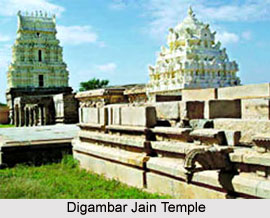 Vijayamangalam was an ancient Jain temple that belonged to the Digambara Sect. Once it served as a popular pilgrimage centre but now it is in a ruined state and thus abandoned. The Digambar Jain temple complex is about 20 km from Erode. While driving down from Coimbatore, it is 27 km from Avanashi on the NH-47. The temple has now been taken by the Archaeological Survey of India.
Vijayamangalam was an ancient Jain temple that belonged to the Digambara Sect. Once it served as a popular pilgrimage centre but now it is in a ruined state and thus abandoned. The Digambar Jain temple complex is about 20 km from Erode. While driving down from Coimbatore, it is 27 km from Avanashi on the NH-47. The temple has now been taken by the Archaeological Survey of India.
The temple is believed to have been built in the 6th Century. The principal deity of the temple is Lord Chandraprabha. The temple was once a popular place of worship for the Jains. Presently the temple is now in a dilapidated state and has undergone the ravages of time. According to the history of this temple, it was visited and deeply revered by the devotees of the Digambar Sect. The presiding deity of the temple, Chandraprabha Swami is a 30-cm idol. However, the idol had been stolen from the temple. Instead of the idol of Chandraprabha, now an idol of Kushmandala Devi and that of Lord Mahavira can be seen here. The temple is presently visited by very few devotees.
Architecture of Digambar Jain Temple
The Digambar Jain Temple had been magnificently decorated with unique architecture work. The dwajastamb of the temple had been carved out of a single stone. It is noticeable even from a distant place. The images of the 24 Jain Tirthankaras are installed here and these have been have been carved on the gopuram. According to history the temple was built by King Konguvelir. The ceilings of the temple have been lavishly adorned with images of dancing girls as well as flowers. Even the pillars of the temple have been decorated with floral motifs. On one side of the temple a statue of a pregnant woman can be seen that symbolizes life. On the other side another statue of a reclining woman can be seen that depicts death. Thus the side panel of the temple represents the life cycle of birth and death.
The top of the temple has also been ornately carved that depicts the birth of Lord Mahavira and his life. It is supposed that a dance mandapam that dates back to the 13th Century was present here. However, presently only the dance floor remains of the ruined mandapam. The exterior walls of the temple are adorned with elaborately carved mythological beasts. It was believed that these beats protected the sanctum sanctorum. Few inscriptions have also been found here that states that few Jain sages had attained nirvana here by fasting till death.
There are many other shrines located at Thingalur and Seenapuram, 10 km away but they are all in dilapidated state. The shrine at Thingalur is surrounded by scenic beauty but it is in complete ruined state. The temple at Seenapuram, a derivation of Jainapuram, is also in bad state.




















